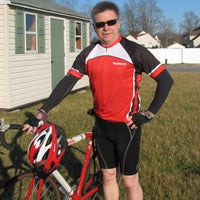Reasons to ride
Published 5:46 pm Saturday, February 16, 2013
Suffolk residents who ride in the American Diabetes Association’s Tour de Cure all have their own reasons.
Ronald F. Mosher, who will ride in his fifth Tour this year, got into bicycling through a friend at work. He now rides in the Tour for the enjoyment, the exercise and to help find a cure for diabetes because he has family members with diabetes.

Ronald Mosher will ride in his fifth Tour de Cure when it sets off from King’s Fork High School on April 20. He said he is motivated because he likes bicycling and wants to support the fight against diabetes.
Michelle de Poo will ride in her first Tour this year. She got involved because her company, Allfirst, is trying to encourage more community involvement among its employees, and she has Type 1 diabetes.
There are only nine weeks until the Tour de Cure, which returns to the city on April 20 after a successful introduction to Suffolk last year. The cycling event takes riders departing from King’s Fork High School on their choice of a 10-mile, 30-mile, 65-mile or 100-mile course to raise money for a cure for diabetes.
“I think it’s a more enjoyable ride now that they moved it to Suffolk,” Mosher said. “We don’t have near as much traffic as we did before.”
Mosher said his friend at work got him interested in riding the Tour de Cure with him. Mosher started with the 65-mile ride but moved up to the 100-miler the very next year.
Though Mosher doesn’t have diabetes himself, the ride has also helped him manage some risk factors, he said.
“The spin classes I take for the training have improved my health a lot,” he said. “My cholesterol and blood pressure are normal now.”
Mosher rides for Team Raytheon, and he and his co-workers raised about $1,500 for the American Diabetes Association last year.
Michelle de Poo also got involved with the Tour through work, when her company began encouraging more volunteerism. She initially signed up to volunteer for the Tour but then decided she wanted to ride.
“I had no plans of actually riding,” she said. “I’m not even sure if I can make these 30 miles, but I’m going to try my hardest.”
De Poo was diagnosed at age 29 with Type 1 diabetes, in which the body does not produce any insulin at all. Only about five percent of diabetics have Type 1. It differs from the far more common Type 2 diabetes, in which the body either does not produce enough insulin or the body’s cells have become resistant to insulin, which is a hormone needed for the body to be able to convert food into energy.
She said being diagnosed with diabetes changed her life, even though wearing an insulin pump has made it “so much easier.” But the thought of the pump is sometimes sobering to think about, she said.
“I have a piece of equipment on my body that’s keeping me alive,” she said.
De Poo said the Tour’s online functions make it easy for participants to raise money because they can set up their own fundraising page, tell their story, upload photos, share it with friends through email and social networking and even send thank-you notes to donors.
“I’m doing pretty good so far,” she said. “I’ve raised about $500.”
She encouraged other people to get involved as well.
“I think it’s a great cause,” she said. “I hope they can get more people, even if they don’t want to ride, to just volunteer with the organization in some way or another.”
For more information on the Tour, visit www.diabetes.org/hamptonroadsvatour.






